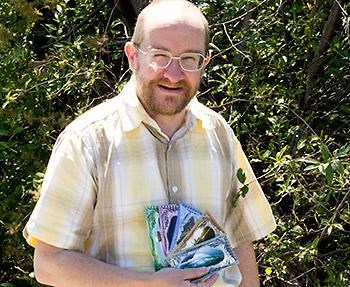More than 16,000 Powell River Dollars (PR$) have been circulated since the currency was rolled out only six months ago. Currency organizers say that the money has been a boon for area non-profits and a help for main-street business.
Kevin Wilson, Sean Melrose and Rob Higgin are the project’s proponents and members of the registered Powell River Money Society, a group comprised of representatives from businesses and non-profits. They started work on the community building initiative in the fall of 2011, presented the currency’s model to Powell River Chamber of Commerce in May 2012. Bills began circulating in November 2012.
“It took us a year to get all our ducks in a row, which is actually pretty fast for creating a local currency,” said Wilson. “For others it could take years.”
Wilson and other members of the society had to recruit businesses and non-profits before the initiative could be started. And they had to design and print the bills.
The bills are made of the same polymer material as Canadian currency which “do okay in the washer but not so well in the dryer,” according to Wilson.
“It was quite a process to get the bills printed,” he said. “You can’t just go down to your local photocopy shop.”
The bills come in one, two, five, 10 and 20-dollar denominations. They reflect Powell River with local artists’ designs.
The bills were printed in Calgary by a company that prints bills from governments around the world, include invisible security features and have the same colour scheme as Canadian bills.
The idea of PR$ is based on Courtenay/Comox’s Community Way dollars, one of over 50 different models for local currencies being used in cities worldwide.
The purpose of the initiative is to strengthen the local economy by having a local currency circulate alongside Canadian dollars. One of the strengths of the model is when a person buys a PR$ they are not taking a Canadian dollar out of circulation, said Wilson.
The system is set up to connect businesses, non-profits and people in a mutually beneficial support cycle.
Businesses donate PR$ to the community organizations, non-profits and school projects of their choice and accept the currency as part payment of a sale at a rate they set. There are currently 30 registered companies in town that accept the currency as well as market vendors and home-based businesses.
Pat Hull, president and general manager of RONA Building Centre is also a board member and past president of Powell River and District United Way.
“We’ve taken in over $1,000 worth and we’ve had a number of customers say they deal exclusively with us because we take them,” said Hull. “The reason we got involved is that this really supports local charities.”
Non-profit organizations spend PR$ at participating businesses, reward volunteers, hire local contractors, and trade PR$ for Canadian currency with their supporters. They can also use them as matching funds when writing grant applications.
People can purchase PR$ three ways: at the city’s two cash points at CMG Printing and Creative Rift Studio and Gallery, through one of the 38 participating non-profit organizations or at events, such as the Open Air Farmers’ Market. When they buy PR$ at a cash point, they are asked to choose which non-profit they want to support. They receive the PR$ at a one-to-one ratio and are able to use the local currency to pay for part of their purchases at participating local businesses.
“The reality is you can still give $100 that you used to but now technically without any cost,” said Hull.
Wilson said that the society has been putting in a lot of hours over the last six months to promote the initiative and has organized events, like a Best Baker contest held in March.
He added the society aims to increase the number of participating businesses up to 100 and to present Powell River Historical Museum and Archives with the first bill of each denomination.
For more information about PR$, readers can visit Powell River Money Society’s website.



